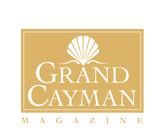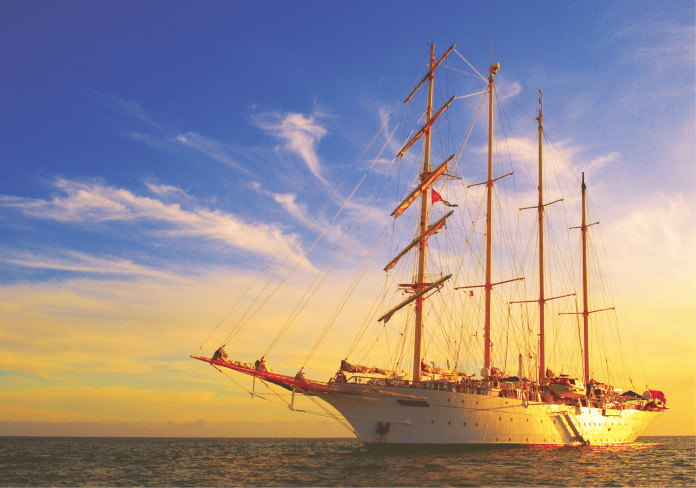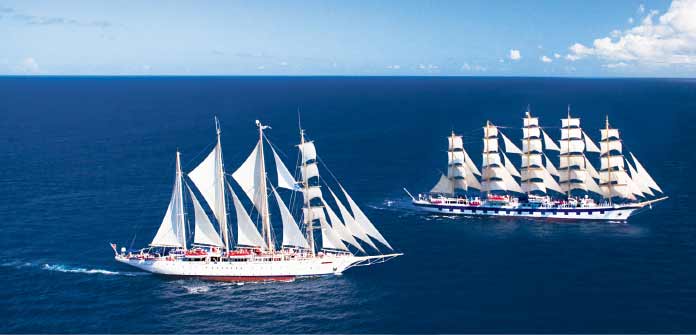George Town’s bustling sidewalks, especially on high season weekdays, are evidence of the popularity of cruises, with millions of visitors – 1,728,444 visitors in 2017 to be precise – disembarking cruise liners onto our shores each year.
Further evidence of this popularity is the revenue. The big three cruise companies, Carnival Corporation, Royal Caribbean Cruises, and Norwegian Cruise Lines, saw 2017 Q3 total revenues of US$5.5 billion, $2.6 billion and $1.7 billion respectively, according to Cruise Industry News.
But these behemoth ships are not the only ones making their way across the world’s seas, transporting guests from one shore to the other, while they are wined and dined the nautical miles in between. Smaller, yet some may say more majestic tall ships, reminiscent of 19th century nautical tales, offer a unique cruising experience, perfect for those with a penchant for both luxury and tradition.
The Star Clipper fleet, owned by the Krafft family, are one such flotilla of tall ships traversing the sailing routes of the world. Depending on the season, itineraries include the Caribbean, Mediterranean, and Southeast Asia, as well as ocean crossings allowing sailing enthusiasts to really see the ships flex the wind-powered muscle and speed which they were originally known for.
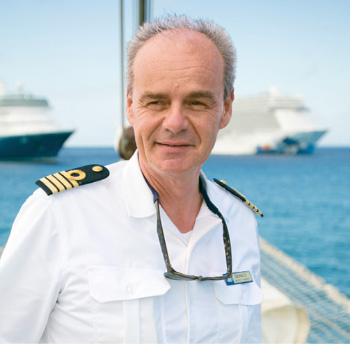
The Star Flyer is one of the triad which make up the fleet, alongside sister ships the Star Clipper and Royal Clipper, and since February 2014 Cayman has enjoyed seeing its masts appear over the horizon as the ship arrived to dock here, with stops both at Grand Cayman and Cayman Brac.
Sadly, the ship will visit no more as it is now due to take over the St. Maarten route from the Star Clipper, who in turn will now sail year-round in Asia. Grand Cayman magazine visited the Star Flyer on its farewell stop in January, guided by Captain Gerald Schoeber, who was soon due to take over from Captain Sergey Utitsyn upon his leave.
Tradition sets sail
The patriarch of the Krafft family, Swedish-born Mikael Krafft, has always had a passion for sailing, evident in the meticulous details of each of his ships, which offer traditional tall ship sailing with modern amenities and facilities.
In his youth Mikael received a small sailing ship from his father, which he sailed around the Swedish Archipelago and to visit the Pommern museum ship in the Åland Islands, solidifying his love of sailing and his dream of owning his own tall ship. His education and early career ultimately led to his founding the White Star Group in Belgium and establishing the Star Clipper line.
 Three years of research followed and using the inspiration of historical 19th century clipper ships the Star Clipper triad was begun. First to launch was the 360-foot Belgium-built Star Flyer in 1991, the first new clipper ship in nearly 100 years, followed by the Star Clipper in 1992. The twin ships are technically “rigged barquentines” with their square-rigged full masts and the remaining masts rigged fore and aft.
Three years of research followed and using the inspiration of historical 19th century clipper ships the Star Clipper triad was begun. First to launch was the 360-foot Belgium-built Star Flyer in 1991, the first new clipper ship in nearly 100 years, followed by the Star Clipper in 1992. The twin ships are technically “rigged barquentines” with their square-rigged full masts and the remaining masts rigged fore and aft.
In another premonition of his future success, Mikael had received in his youth a model of the 1902 German sailing ship Preussen, and thought, “One day, I will build that.” And build it he did, launching the 400-foot, masted, fully square-rigged, 42-sailed vessel the Royal Clipper in 2000, based on the Preussen, and holding the title of the largest square-rigged ship in service.
A fourth sister ship is being built in Split, Croatia, and will be christened The Flying Clipper. Modelled on the 18th century ship France II, she will measure 525 feet long, with five majestic masts, and will stretch her sails for an inaugural cruise this year or next.
19th century inspiration
While it is one of the smallest of the fleet, the Star Flyer is no less magnificent, measuring in at 2,298 tons and 360 feet long.
Large yards span its 50-foot beam, and the four masts extend to a maximum 226 feet above, with 16 sails ready to spread an enormous 36,000 square feet below them.
The inspiration provided by the 19th century tall ships is evident in all aspects of the Star Flyer’s design, with the addition of modern modifications, of course. Outside, expansive teak decks span the aft deck, sun deck and fore deck, with two plunge pools, sunbathing space and a tropical bar catering to guests.
The piano bar takes center stage inside the main deck, overlooked by a porthole allowing light to stream in from the pool which lies above.

Downstairs on the clipper deck, an open seating dining room accommodates up to 180 guests, in either booths or traditional tables, and daily changing lunch buffet and dinner menus keep guests and crew happy. From here, a doorway leads to the Sloop Shop and cabin corridors.
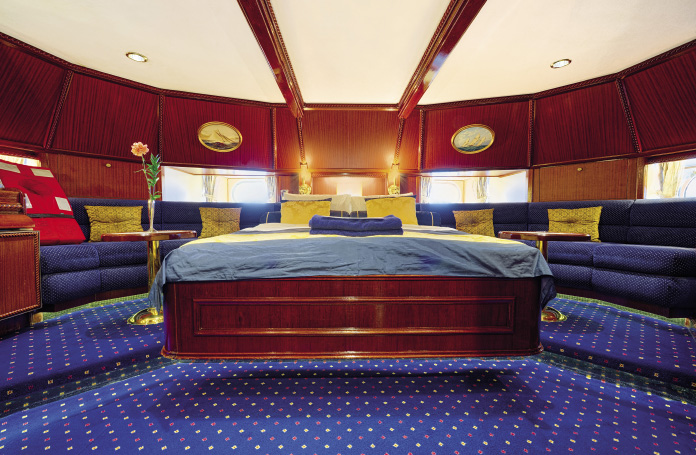
Cabins span seven grades over the clipper and commodore decks, from the Owner’s Cabin, complete with whirlpool baths and deck access, to inside cabins, and all are surprisingly spacious, with 81 out of 85 having a porthole or deck access. Mikael wanted them to have the feel of a private yacht and designed them as such.

Midway between aft and sun deck sits an Edwardian-style library, providing a cozy space for passengers to kick back and relax with a book beside the Belle Époque fireplace.
Antique prints and paintings depicting famous sailing ships are featured throughout the ship, as are teak and mahogany rails, antique style candle sconces, and nautical carpets.
Historical details
As the ship’s design has been modeled on historical tall ships, other details also hark back to bygone eras and customs.
“We try to keep tradition,” says Captain Schoeber, and this is evident in noticeable aspects of the ship.
One feature is the small gold cannon affixed to the fore deck of the ship. While it now flies the red-and-white Maltese maritime flag, displaying the cross of the order of St. John, Star Flyer first sailed under the Luxembourg flag. Old Luxembourg maritime regulation states that every ship should have at least one gun and the King of Luxembourg accordingly gifted this canon to the ship where it remains to this day.
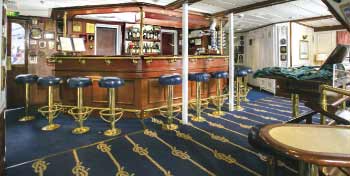
Inside, traditional aspects continue. Surrounding the Piano Bar hang numerous plaques, gifted from harbors on the inaugural visit of the Star Flyer to their ports, as tradition dictates.
Ships traditionally have assigned Godmothers, or sponsors for non-passenger ships, and Star Flyer does not waiver from this. In the ship’s library hangs a portrait of her Godmother, Anne Kraaft, Mikael’s wife. As Star Clippers is a family business it is no surprise that members of the family are also featured in other ways, with daughter Marie Kraaft’s face appearing on the figurehead of the Star Clipper.
Running the ship
A staff of 72 assist a maximum passenger capacity of 170 made up mostly of British and European passengers, with increasing numbers of U.S. guests. A high number of these are return passengers, with repeat guest rates for the fleet at more than 60 percent. It seems once you are bitten by the Clipper bug it is hard to turn to other forms of cruising.
Staff is on board for months at a time. “We all rotate between the three ships in the fleet,” says Captain Schoeber. “Usually the captain is on board for four months, officers for six months, and crew up to ten months.”
Captain Schoeber explained that three major departments oversee the running of the ship. The Technical Department deals with navigation and the operation of the ship; the Hotel Department deals with provisions, bar, housekeeping, and the like; and the Engine Department deals with operation, maintenance and repair of systems including the propulsion system.
Overseen by the Hotel Manager, fresh loading of fruits and vegetables takes place on a weekly basis, and master loading – three containers; one fresh, one frozen and one consumable – every 21 days.
At their Cayman stop, the ship was a busy place. Our port was used as a major logistical stop on their route, and the ship was abuzz with crew from each department carrying out their duties.
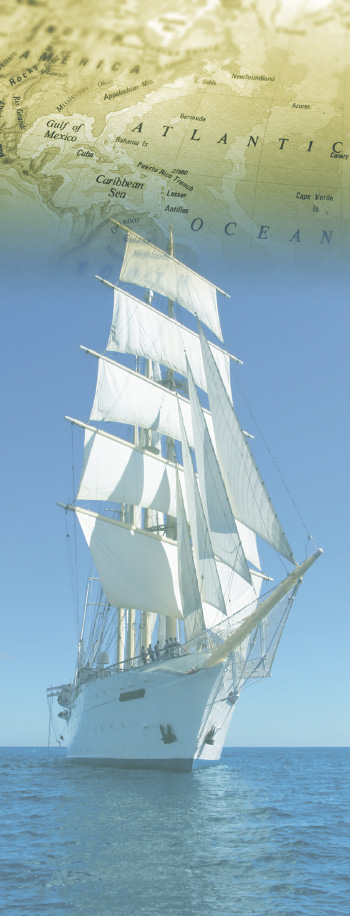 Men scaled the masts to tend sails while others loaded fresh produce on board, or hoisted bags of waste onto the dock for disposal, and more cleaned and fixed whatever was necessary to make the onward journey to Cayman Brac, and beyond, a comfortable one.
Men scaled the masts to tend sails while others loaded fresh produce on board, or hoisted bags of waste onto the dock for disposal, and more cleaned and fixed whatever was necessary to make the onward journey to Cayman Brac, and beyond, a comfortable one.
The small pier at George Town is quite challenging to dock at. “There is not much space for maneuver due to the shallow water,” explains Captain Schoeber, “and it is also difficult due to the ‘Monsters of the Sea’”, a reference to the large cruise ships in port.
Tall ship mentality
Cruising on a tall ship is unsurprisingly different to cruising on one of these ‘monsters.’ “We are more or less a little bigger than a private sailing yacht, sailing with an average of 150 passengers – sailing friends – from all over the world,” explains Captain Schoeber. “With no skills required on their part,” he adds jokingly.
This reference to the passengers as “friends” is representative of the Star Clipper philosophy and the fellowship experienced on board.
Because of small passenger numbers, guests mingle and chat to one another, learning each other’s stories and making new friends. This personal interaction extends to activities as well. There are no gargantuan water slides or jumbotrons on tall ships, instead, knot-tying lessons, raising sails, and a climb to the first crow’s nest are all activities offered, weather permitting. Some guests can even take the wheel for a moment, under supervision, of course.
Watersports activities while in port, spa services, and scheduled on-board activities are all also available.
Plotting a course
The final call of the Star Flyer’s Caribbean cruise season, which has also taken in Cienfuegos, Jamaica, Dominican Republic, and the British Virgin Islands, is St. Maarten, from where weekly cruises take place until the end of March.
The Star Flyer will then make the long open sea journey to Lisbon, with a stop in the Azores. Captain Schoeber explained that every two to two and a half years the ship goes into dry dock in Lisbon for 14 days for repairs and upkeep. Once spruced up, she will start her Mediterranean season, which includes routes stopping at ports such as Gibraltar, Malaga, Barcelona, St. Tropez, Cannes, Monaco, and Athens, to name just a few.
The Mediterranean season includes what is Captain Schoeber’s favorite port to dock in – Venice. “The tourists are all taking pictures in the Piazza San Marco, but when our ship enters port with its sails they turn to look and take pictures of it!”
While it is a shame that Cayman will no longer be enjoying this dramatic entrance of a tall ship, the proximity of the Star Clipper fleet’s remaining Caribbean routes, and the allure of its Mediterranean and Asian routes, still offer a more traditional option to cruising if the call of the sea is strong enough and an admiration of tradition is present.
















